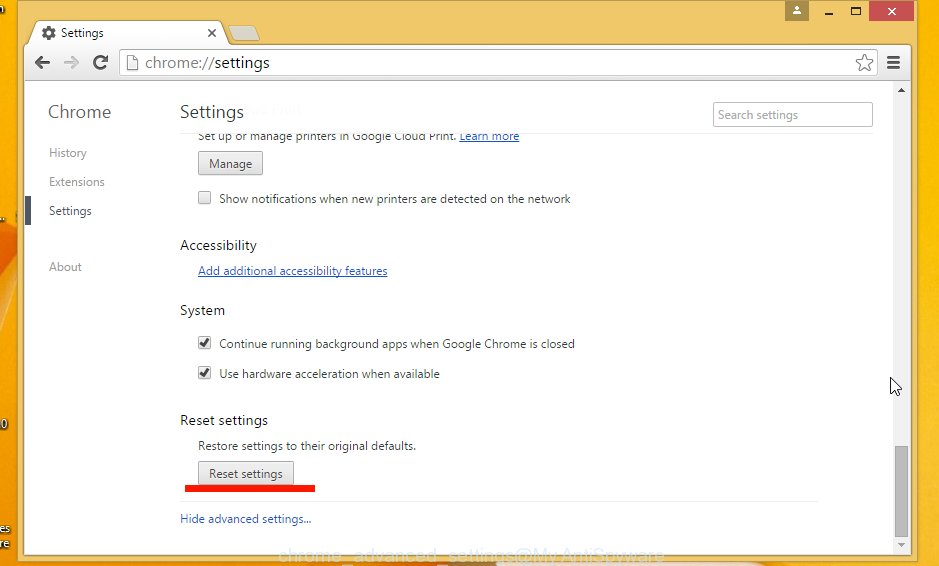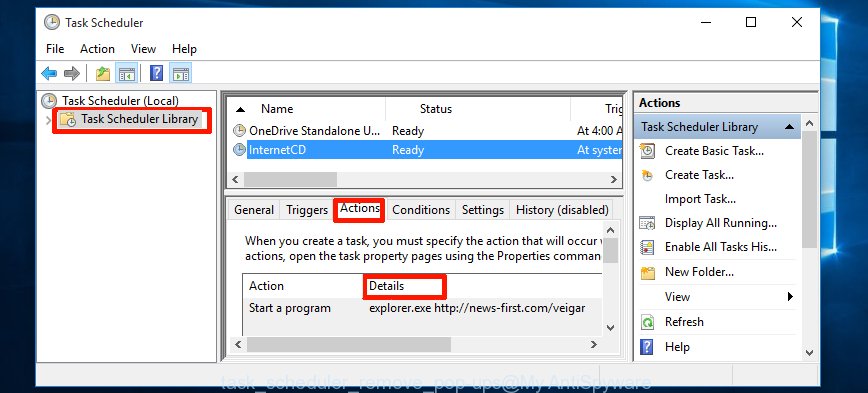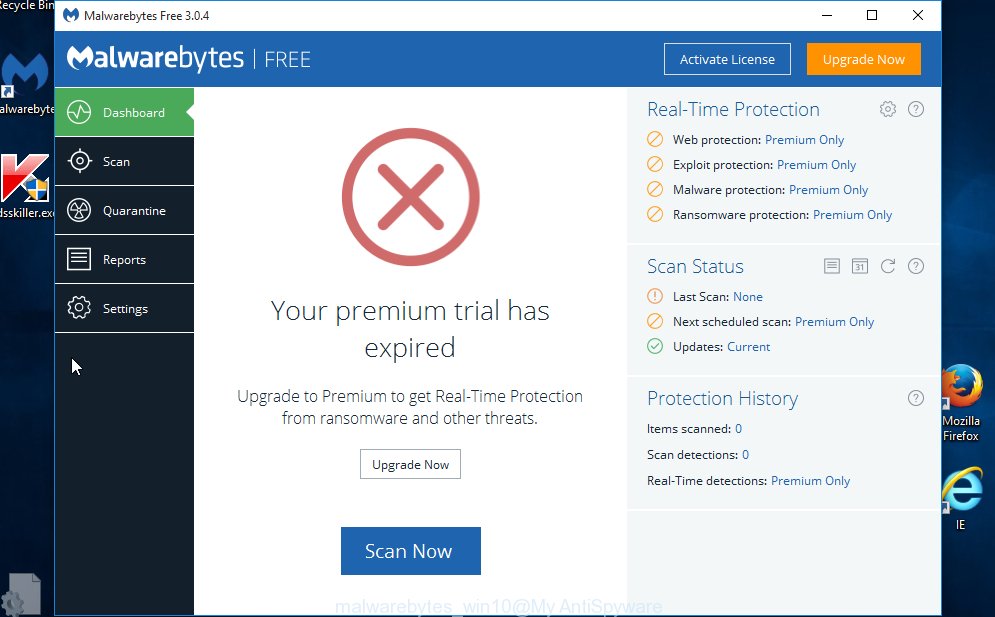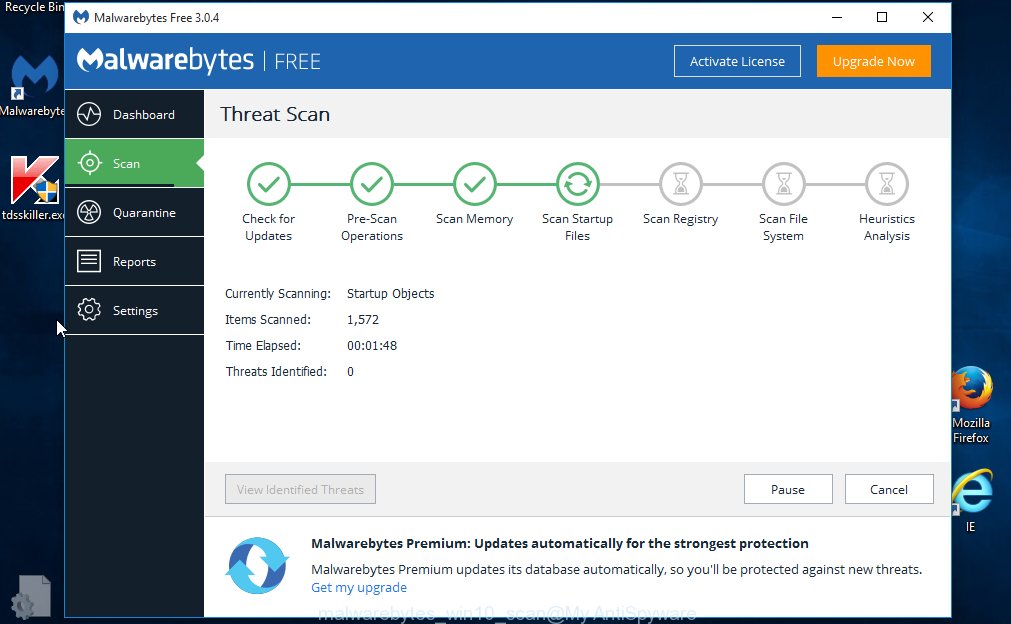Have you become that your browser randomly shows Facebook, instead of the one you want to see? It is a sign that you have an installed ‘ad-supported’ software (also known as adware) on your system. The adware is a part of harmful software that created to open a ton of intrusive popup ads. You need to follow the instructions below as quickly as possible. It will clear your personal computer from adware that generates a lot of pop-up advertisements in the web browser and thereby get rid of the redirect to Facebook site.
The ‘ad supported’ software is the part of the software that is used as an online promotional tool. It’s made with the sole purpose to show dozens of pop-up advertisements, and thus to promote the goods and services in an open web-browser window. So, the Facebook is just one of the many web sites of the so-called ‘ad-support’ type. It’s designed to fill the web-browser’s constant stream of ads, or reroute the browser to not expected and intrusive advertising web-sites. Moreover, the adware can substitute the legitimate advertising links on misleading or even banners that can offer to visit malicious pages. The reason is simple, many advertisers agree on any ways to attract users to their web-pages, so the creators of ad-supported software, often forcing users to click on an advertising link. For each click on a link, the authors of the adware receive income. It is the so-called ‘Pay-Per-Click’ method.
The ‘ad supported’ software usually affects only the FF, Chrome, Microsoft Internet Explorer and Edge by changing the internet browser’s settings or installing a harmful extensions. Moreover, possible situations, when any other internet browsers will be affected too. The adware will perform a scan of the PC for web browser shortcuts and modify them without your permission. When it infects the browser shortcuts, it’ll add the argument such as ‘http://site.address’ into Target property. So, each time you launch the internet browser, you will see an intrusive web site.
So, obviously, you need to get rid of the ad supported software ASAP. Use the free step-by-step guide below. This guide will help you clean your computer of ad-supported software and thereby delete undesired Facebook pop-up ads.
Table of contents
- What is Facebook
- How to remove Facebook ads
- How to manually delete Facebook pop-up ads
- Delete suspicious and potentially unwanted software using MS Windows Control Panel
- Fix infected internet browsers shortcuts to delete Facebook redirect
- Delete Facebook redirect from Microsoft Internet Explorer
- Remove Facebook pop up ads from Google Chrome
- Remove Facebook from FF by resetting internet browser settings
- Delete unwanted Scheduled Tasks
- Scan your system and remove Facebook pop ups with free tools
- How to manually delete Facebook pop-up ads
- Stop Facebook pop-ups
- Where the Facebook pop-ups comes from
- Final words
How to remove Facebook ads
Most often ad-supported software requires more than a simple uninstall with the help of MS Windows Control panel in order to be fully uninstalled. For that reason, our team designed several removal solutions which we’ve summarized in a detailed tutorial. Therefore, if you’ve the unwanted Facebook pop up advertisements on your personal computer and are currently trying to have it uninstalled then feel free to follow the tutorial below in order to resolve your problem. Certain of the steps will require you to restart your PC or exit the web-site. So, read this guidance carefully, then bookmark or print it for later reference.
How to manually delete Facebook pop-up ads
Most common adware may be uninstalled without any antivirus programs. The manual ‘ad supported’ software removal is blog post tutorial that will teach you how to remove the Facebook ads.
Delete suspicious and potentially unwanted software using MS Windows Control Panel
First method for manual adware removal is to go into the Microsoft Windows “Control Panel”, then “Uninstall a program” console. Take a look at the list of applications on your PC and see if there are any suspicious and unknown software. If you see any, you need to delete them. Of course, before doing so, you can do an Web search to find details on the application. If it is a potentially unwanted application, ad supported software or malware, you will likely find information that says so.
Windows 8, 8.1, 10
First, click the Windows button
Windows XP, Vista, 7
First, press “Start” and select “Control Panel”.
It will open the Windows Control Panel as on the image below.

Next, click “Uninstall a program” ![]()
It will display a list of all applications installed on your machine. Scroll through the all list, and uninstall any suspicious and unknown applications. To quickly find the latest installed applications, we recommend sort applications by date in the Control panel.
Fix infected internet browsers shortcuts to delete Facebook redirect
Now you need to clean up the internet browser shortcuts. Check that the shortcut referring to the right exe-file of the browser, and not on any unknown file.
Right click to a desktop shortcut for your web browser. Choose the “Properties” option. It will open the Properties window. Select the “Shortcut” tab here, after that, look at the “Target” field. The adware can rewrite it. If you are seeing something like “…exe http://site.address” then you need to remove “http…” and leave only, depending on the web browser you are using:
- Google Chrome: chrome.exe
- Opera: opera.exe
- Firefox: firefox.exe
- Internet Explorer: iexplore.exe
Look at the example as shown in the figure below.

Once is complete, click the “OK” button to save the changes. Please repeat this step for browser shortcuts which redirects to an intrusive pages. When you have completed, go to next step.
Delete Facebook redirect from Microsoft Internet Explorer
By resetting IE web browser you restore your web-browser settings to its default state. This is first when troubleshooting problems that might have been caused by adware that causes lots of unwanted Facebook pop-up ads.
First, open the Internet Explorer. Next, click the button in the form of gear (![]() ). It will show the Tools drop-down menu, click the “Internet Options” as shown below.
). It will show the Tools drop-down menu, click the “Internet Options” as shown below.

In the “Internet Options” window click on the Advanced tab, then click the Reset button. The IE will show the “Reset Internet Explorer settings” window as shown below. Select the “Delete personal settings” check box, then click “Reset” button.

You will now need to reboot your machine for the changes to take effect.
Remove Facebook pop up ads from Google Chrome
Reset Google Chrome settings is a simple way to get rid of the adware, harmful and adware extensions, as well as to recover the browser’s newtab page, startpage and search engine by default that have been replaced by ad-supported software that developed to reroute your browser to various ad pages such as Facebook.
First run the Chrome. Next, click the button in the form of three horizontal stripes (![]() ). It will display the main menu. Further, click the option named “Settings”. Another way to show the Google Chrome’s settings – type chrome://settings in the web-browser adress bar and press Enter.
). It will display the main menu. Further, click the option named “Settings”. Another way to show the Google Chrome’s settings – type chrome://settings in the web-browser adress bar and press Enter.

The browser will show the settings screen. Scroll down to the bottom of the page and click the “Show advanced settings” link. Now scroll down until the “Reset settings” section is visible, as on the image below and press the “Reset settings” button.

The Google Chrome will open the confirmation dialog box. You need to confirm your action, press the “Reset” button. The browser will start the process of cleaning. Once it’s finished, the browser’s settings including new tab, startpage and search engine by default back to the values that have been when the Chrome was first installed on your PC.
Remove Facebook from FF by resetting internet browser settings
The Mozilla Firefox reset will keep your personal information such as bookmarks, passwords, web form auto-fill data, recover preferences and security settings, get rid of redirects to annoying Facebook web-page and adware extensions.
Click the Menu button (looks like three horizontal lines), and press the blue Help icon located at the bottom of the drop down menu as shown on the screen below.

A small menu will appear, click the “Troubleshooting Information”. On this page, click “Refresh Firefox” button as shown on the image below.

Follow the onscreen procedure to restore your Mozilla Firefox web-browser settings to its original state.
Delete unwanted Scheduled Tasks
If the intrusive Facebook site opens automatically on Windows startup or at equal time intervals, then you need to check the Task Scheduler Library and remove all the tasks that have been created by adware.
Press Windows and R keys on your keyboard together. It will display a dialog box that called Run. In the text field, type “taskschd.msc” (without the quotes) and press OK. Task Scheduler window opens. In the left-hand side, click “Task Scheduler Library”, like below.

Task scheduler, list of tasks
In the middle part you will see a list of installed tasks. Select the first task, its properties will be open just below automatically. Next, click the Actions tab. Necessary to look at the text which is written under Details. Found something such as “explorer.exe http://site.address” or “chrome.exe http://site.address” or “firefox.exe http://site.address”, then you need remove this task. If you are not sure that executes the task, then google it. If it is a component of the adware, then this task also should be removed.
Further click on it with the right mouse button and select Delete as shown on the screen below.

Task scheduler, delete a task
Repeat this step, if you have found a few tasks that have been created by adware. Once is finished, close the Task Scheduler window.
Scan your system and remove Facebook pop ups with free tools
After completing the manual removal instructions above all unwanted applications and internet browser’s extensions which causes browser redirects to the Facebook web-site should be uninstalled. If the problem with Facebook ads is still remained, then we recommend to scan your personal computer for any remaining malicious components. Use recommended free adware removal programs below.
Run Zemana Anti-malware to remove Facebook ads
Zemana Anti-malware highly recommended, because it can scan for security threats such adware and adwares which most ‘classic’ antivirus software fail to pick up on. Moreover, if you have any Facebook redirect removal problems which cannot be fixed by this tool automatically, then Zemana Anti-malware provides 24X7 online assistance from the highly experienced support staff.

- Download Zemana anti-malware (ZAM) by clicking on the link below.
Zemana AntiMalware
164813 downloads
Author: Zemana Ltd
Category: Security tools
Update: July 16, 2019
- When downloading is complete, close all software and windows on your PC. Open a directory in which you saved it. Double-click on the icon that’s named Zemana.AntiMalware.Setup.
- Further, click Next button and follow the prompts.
- Once installation is complete, click the “Scan” button to perform a system scan with this utility for the adware that causes internet browsers to display annoying Facebook popup ads. When a malware, ad supported software or potentially unwanted software are detected, the count of the security threats will change accordingly.
- When the system scan is finished, it’ll display a list of all threats detected by this tool. When you are ready, press “Next”. Once disinfection is finished, you may be prompted to reboot your personal computer.
Automatically delete Facebook redirect with Malwarebytes
We recommend using the Malwarebytes Free. You can download and install Malwarebytes to find adware and thereby delete Facebook pop up ads from your browsers. When installed and updated, the free malware remover will automatically scan and detect all threats exist on the PC system.
Download Malwarebytes Free on your computer by clicking on the link below. Save it on your desktop.
327070 downloads
Author: Malwarebytes
Category: Security tools
Update: April 15, 2020
When downloading is finished, close all windows on your computer. Further, run the file named mb3-setup. If the “User Account Control” dialog box pops up like below, click the “Yes” button.

It will show the “Setup wizard” that will allow you install Malwarebytes on the personal computer. Follow the prompts and do not make any changes to default settings.

Once installation is done successfully, click Finish button. Then Malwarebytes will automatically start and you can see its main window as shown on the image below.

Next, click the “Scan Now” button to start checking your computer for the ad-supported software that cause annoying Facebook pop ups to appear. A system scan can take anywhere from 5 to 30 minutes, depending on your computer. While the tool is scanning, you can see how many objects it has identified either as being malware.

When it has finished scanning, you can check all threats detected on your machine. When you are ready, click “Quarantine Selected” button.

The Malwarebytes will begin removing ad-supported software and other security threats. Once disinfection is complete, you can be prompted to restart your PC system. We recommend you look at the following video, which completely explains the procedure of using the Malwarebytes to delete ad supported software, adware and other malicious software.
Remove Facebook pop-up ads and harmful extensions with AdwCleaner
AdwCleaner is a free portable program that scans your PC system for ‘ad supported’ software that created to redirect your browser to various ad web-pages like Facebook, PUPs and hijackers and helps remove them easily. Moreover, it’ll also allow you delete any harmful internet browser extensions and add-ons.

- Download AdwCleaner by clicking on the link below.
AdwCleaner download
225545 downloads
Version: 8.4.1
Author: Xplode, MalwareBytes
Category: Security tools
Update: October 5, 2024
- When the download is complete, double click the AdwCleaner icon. Once this tool is started, press “Scan” button for checking your system for the ‘ad supported’ software that causes web browsers to display intrusive Facebook advertisements. Depending on your computer, the scan can take anywhere from a few minutes to close to an hour. While the utility is scanning, you can see how many objects it has identified as being infected by malicious software.
- When the system scan is done, you can check all threats detected on your machine. Review the report and then click “Clean” button. It will open a prompt, press “OK”.
These few simple steps are shown in detail in the following video guide.
Stop Facebook pop-ups
Run ad-blocking application such as AdGuard in order to stop ads, malvertisements, pop-ups and online trackers, avoid having to install harmful and adware browser plug-ins and add-ons that affect your PC performance and impact your computer security. Surf the Internet anonymously and stay safe online!
Installing the AdGuard ad blocker application is simple. First you’ll need to download AdGuard by clicking on the following link.
26842 downloads
Version: 6.4
Author: © Adguard
Category: Security tools
Update: November 15, 2018
When downloading is finished, double-click the downloaded file to run it. The “Setup Wizard” window will show up on the computer screen like below.

Follow the prompts. AdGuard will then be installed and an icon will be placed on your desktop. A window will show up asking you to confirm that you want to see a quick guide as shown on the image below.

Click “Skip” button to close the window and use the default settings, or click “Get Started” to see an quick tutorial which will allow you get to know AdGuard better.
Each time, when you run your computer, AdGuard will launch automatically and block popup ads, Facebook pop-ups, as well as other harmful or misleading web sites. For an overview of all the features of the application, or to change its settings you can simply double-click on the AdGuard icon, that is located on your desktop.
Where the Facebook pop-ups comes from
The ad-supported software usually come bundled with various freeware. Most often, it can be bundled within the installers from Softonic, Cnet, Soft32, Brothersoft or other similar web sites. So, you should run any files downloaded from the World Wide Web with great caution, read the User agreement, Software license and Terms of use. In the process of installing a new application, you should choose a Manual, Advanced or Custom install mode to control what components and additional programs to be installed, otherwise you run the risk of infecting your computer with an adware that causes internet browsers to show annoying Facebook advertisements.
Final words
Now your computer should be clean of the adware that displays unwanted Facebook pop-up ads. Remove AdwCleaner. We suggest that you keep AdGuard (to help you block unwanted pop ups and annoying harmful web pages) and Zemana Anti-malware (to periodically scan your computer for new malware, hijackers and adware). Make sure that you have all the Critical Updates recommended for Windows OS. Without regular updates you WILL NOT be protected when new hijackers, malicious software and adware are released.
If you are still having problems while trying to get rid of Facebook redirect from your internet browser, then ask for help in our Spyware/Malware removal forum.


















